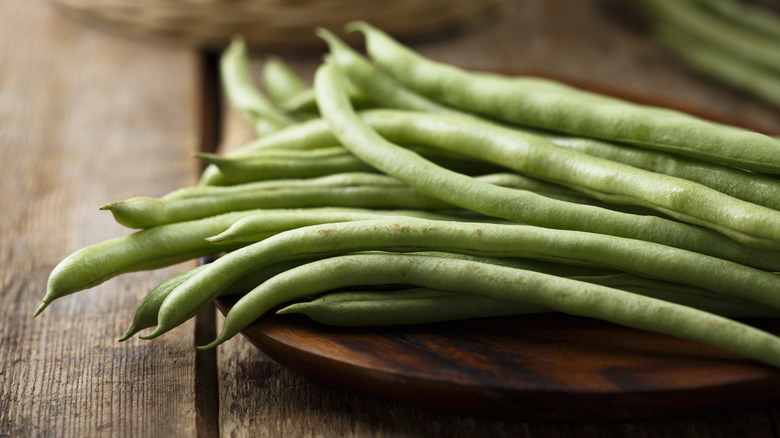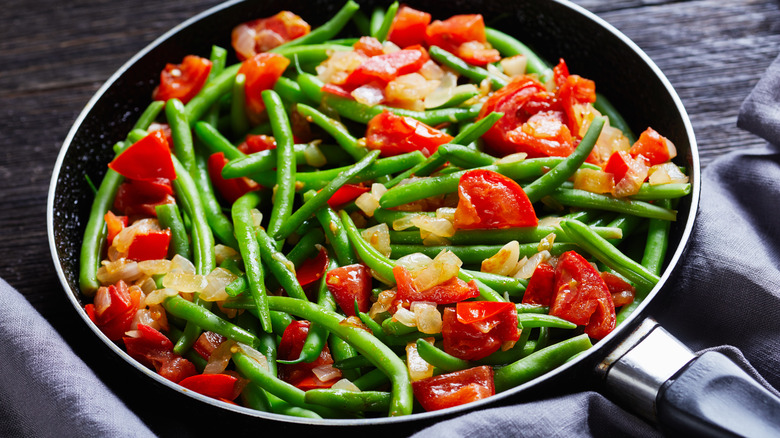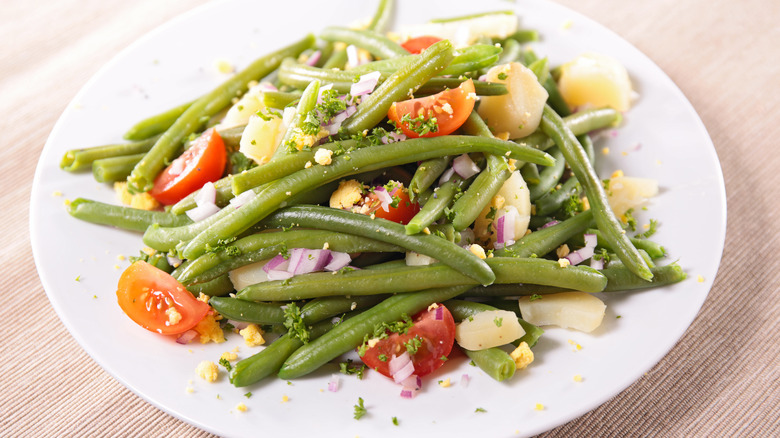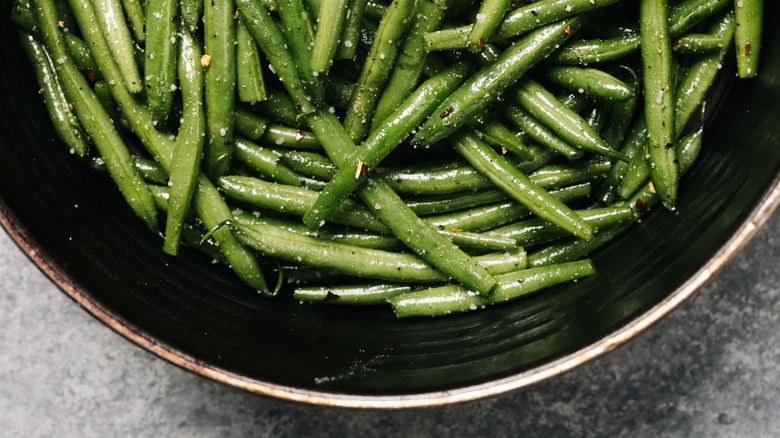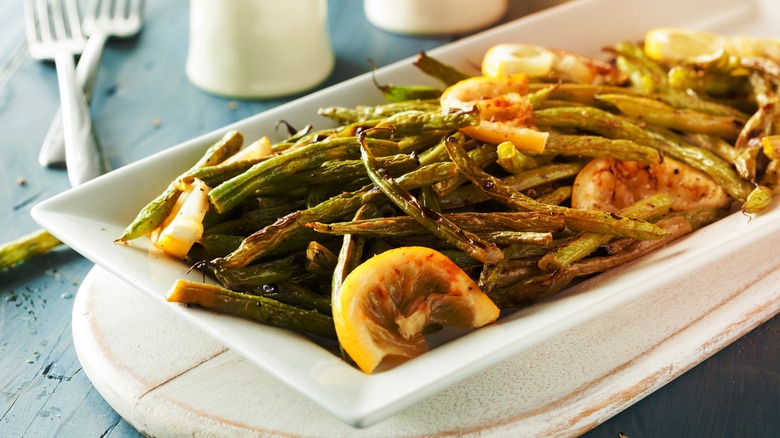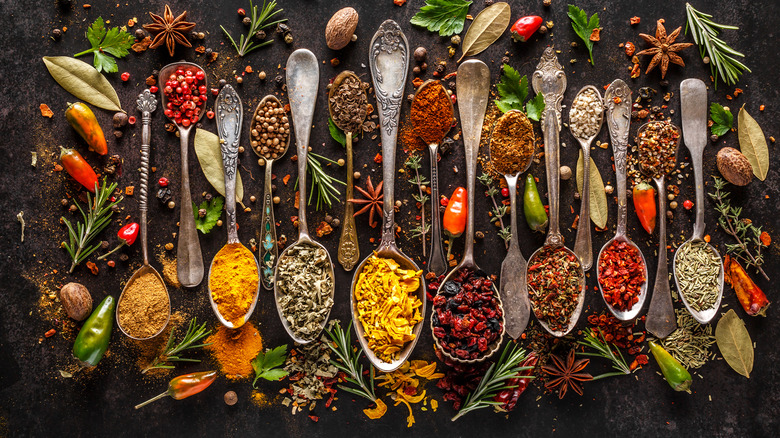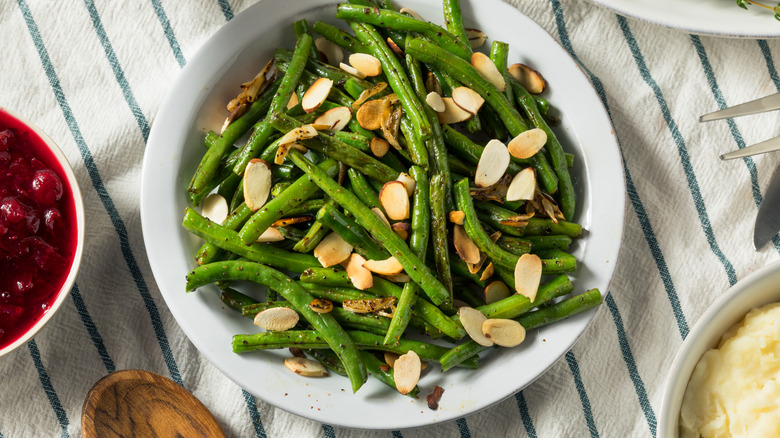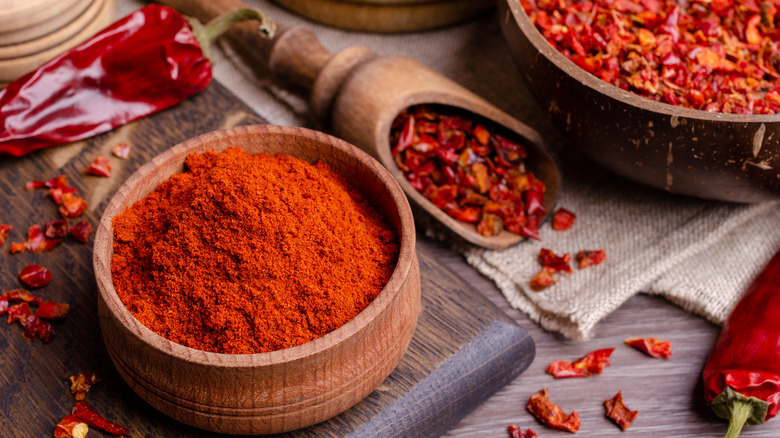11 Ways To Upgrade Your Green Beans
Vegetables are an essential part of a healthy diet, providing a wide range of benefits to our bodies. However, while some people may love vegetables and make them a regular part of their meals, others may not be so fond of them. This can be due to a variety of reasons, including taste preferences, past experiences, or lack of exposure to different types of vegetables. But incorporating produce into your daily meals doesn't have to be hard; let's begin with green beans.
Also known as string beans or snap beans, they're a versatile and nutritious green that can easily be integrated into any type of diet. As a member of the legume family, they are considered to be a mild-tasting vegetable that has a slightly sweet, grassy flavor. They are an expert favorite and beginner-friendly veggie that is available year-round at supermarkets.
As per Medical News Today, green beans are rich in vitamins, folic acid, and fiber. They're good for you, sure, but they may not be the most appealing or tasty food to consume. Though they're often considered to be rather bland on their own, with the addition of other ingredients and seasonings, green beans can be undeniably transformed into a more flavorful side dish for your next meal. Choose for yourself which ingredients will take the beans to the next level. Experiment with different methods of preparation and seasonings to discover which upgrade is your favorite way to enjoy eating green beans.
1. Sauté in a skillet
Sautéing is a quick method for cooking green beans that results in a delicious bite. This is a great way to add some extra greens to your plate, whether you're serving it with grilled chicken or fish. Typically, a frying pan with some oil is warmed before the contents are added. Medium to high heat brings out the best features the bean has to offer, including a better textural appeal. "I strongly prefer sautéing — this preserves the integrity of the beans, keeps them crisp, and takes very little time," Charlie McKenna, founder of Chicago restaurant Lillie's Q, told Insider. The idea is to cook the beans long enough to be soft yet still crunchy.
Perfect, you have the cooking technique. Now, let's talk about the type of green beans you should be using before turning on the burner. Snap beans come in many varieties, including stringless and haricot vert. These are all suitable for this method of cooking, but haricots verts are generally considered more flavorful and tender. This type of green bean is typically longer, thinner, and doesn't taste like it came out of a can. Once they are trimmed and washed, add them to a pan with butter and oil and sauté for at least seven minutes. For even more added flavor, you can consider stirring in some onions or even tomatoes. Simply slice white or yellow onions into thin rings or dice and heat along with the green beans until caramelized.
2. Boil and serve cold
Boiled green beans are a classic way to cook the vegetable that's super fast and equally as simple. Just some boiling water in a pot and a few minutes, and they're ready to be served. While normally enjoyed warm with some salt, pepper, and olive oil, these boiled beans are actually quite good cold. That's right, you can serve green beans long after they have cooled. They are frequently enjoyed in cold salads on hot summer days and are great for dipping as part of an appetizer tray or snack. Don't take too long to gobble the green beans up, though, as they can only be preserved for a few days after they have been prepared.
If you want a crispier bean, consider blanching. The green beans do need to be washed and trimmed as normal before being placed in the pot. The process of blanching helps preserve the beans' color and texture, as well as make them more digestible by slowing the loss of vitamins and minerals (via Clemson). To blanch green beans correctly, cook them in a pot of boiling water for about three minutes until they turn a bright shade of green but are still firm enough to snap. Once you remove them from the hot water, submerge them in an ice bath for up to five minutes to stop the cooking process. This method also ensures the beans last a bit longer when properly stored in the refrigerator compared to boiled ones.
3. Make them crispy in the air fryer
Air fryers have become a popular go-to appliance in home kitchens and for good reason. The convection ovens allow you to cook a plethora of foods with little to no oil, resulting in a healthier consumable compared to traditional deep-frying. Using an air fryer can save time and energy as well, and unlike traditional cooking methods, it does not require time for preheating and often performs the job faster. One of the many foods that can be cooked in an air fryer is green beans.
One of the great things about cooking green beans using hot circulating air is that the technique allows the veggie to retain its vibrant green color and have a nice, crisp texture when finished. Whether you prefer your green beans crispy or charred, an air fryer can help achieve the perfect consistency. The vegetable can be simply seasoned with salt, pepper, garlic powder, or any of your favorite herbs and spices for additional flavor. Or you can go all out and create a healthier twist on the classic french fry by coating the string beans in a parmesan breadcrumb mixture. Whether you decide to eat them subtly flavored or dip them in a side of ranch dressing air-frying is sure to be a favorite green bean recipe upgrade around the dinner table.
4. Roast them with lemons
Green beans are the unsung heroes of the vegetable world. They're often overlooked in favor of flashier veggies like broccoli or Brussels sprouts, but let us tell you, these little green guys deserve some serious recognition. One of the best ways to showcase their potential is by roasting them.
Roasting is a simple yet delicious way to prepare green beans. The high heat of the oven caramelizes the natural sugars in the beans, giving them a slightly sweet yet nutty flavor. The key factors to successful roasted green beans are to use a high temperature and to keep the beans moving in the pan so they cook evenly. That means reaching into the oven every few minutes to give the pan a good shake or gently shuffle the string beans with a spoon or spatula. It is recommended to season the beans to your preferences prior to baking.
You can toss the green beans in any oil and your choice of seasonings, but consider using fresh lemon. When paired with fresh lemon slices, the green beans take on a bright and zesty taste that pairs well with a variety of proteins, from fish to beef. But wait, there's more! Roasting green beans with lemon also makes them a blank canvas for adding all sorts of other flavors. Want to add a little Mediterranean flair? Toss in some chopped garlic and lemon zest before roasting. Feeling a bit spicy? Sprinkle on some chili flakes or cumin. The possibilities are endless.
5. Steam in a foil pack
While they may be common at campsites, foil packs are just as easy to make right at home. They allow you to cook with minimal prep and cleanup and maximum flavor and are convenient to use when cooking for a crowd or for individual portions. You can fill foil packs with just about any type of food, from proteins to vegetables. Steaming green beans in a foil pack is the ultimate game-changer. You can prepare them in advance, store them in the refrigerator or freezer, and then cook them when you're ready to eat. This makes it easy to have a quick and healthy meal on hand at all times.
Green beans, the sidekick of the vegetable world, are prepared in foil packs similarly to other popular vegetables such as zucchini and squash: The food is placed in the middle of the aluminum foil before it is folded and sealed. You can place a small amount or a whole pound of beans together. The packet of food is then steamed and cooked in its own juices and added seasonings. This method of cooking infuses the beans with delicious flavors that you never knew they were capable of. The packets can be placed on a grill, in an oven, or over a campfire to help introduce new flavor profiles to bland beans and your taste buds. You can add garlic, butter, herbs, Parmesan cheese, and spices to create a well-balanced bite.
6. Season with multiple spices
Sometimes plain steamed or boiled green beans become a bit monotonous. That's where spices come in! From cooking with warm, pungent flavors to ones that add a kick, the options are boundless. Green beans are a versatile vegetable with a minimal taste that acts as a blank canvas for a smattering of other ingredients. There are so many to choose from that it can be overwhelming to decide which ones to use. With some knowledge and simple seasonings, you can transform boring beans into a flavorful dish that is sure to impress even the most discerning palate.
When it comes to seasoning green beans, the key is to experiment and find the combination of spices you like best. You can choose to include just one component or use several together. Multiple seasonings such as garlic powder, ground onion, red pepper flakes, turmeric, cumin, and Bohnenkraut are some popular choices. Most of these ingredients are kitchen staples in a spice cabinet, while others are a bit more exotic. Two of the most common spices, garlic and onion powder, are a classic pairing that can add a truly delicious depth of flavor. For those who prefer a touch of heat, sprinkle in black or cayenne pepper. A little goes a long way. Remember the whole point is to enhance the flavor of the beans, not overpower it, so it's best to use spices in moderation. You can season green beans with any of these elements regardless of the cooking method.
7. Add a savory taste with bacon
One delicious way to upgrade a green bean side dish from flat to flavorful is by cooking the veggie with bacon. This classic duo is perfect for holiday meals, weeknight dinners, and picky eaters. Fresh green beans, crisp bacon, and butter or oil are all you need to make this meal. The bacon is cooked until crispy and then crumbled, and the green beans are sautéed in the bacon fat, giving them a rich and savory flavor. You can even try wrapping individual beans in strips of bacon for a nice crunch and visual presentation.
Not just any bacon will do. To really take your green beans to the next level, make sure you pick the right cut for the meal. The thickness of the protein can make a big difference in the final outcome of the dish. Thick-cut bacon, also known as "thick-sliced" bacon, typically cooks and holds up better compared to thinner pieces. This is because it is harder to pull moisture out of thicker slices, per Cook's Illustrated. This style of bacon is typically sliced in pieces measuring around ¼ to ½ inch thick. Because of its size, this variety of meat will not shrink as much, and it will retain its texture throughout the cooking process.
Bacon-cooked green beans can be served with pork, chicken, or beef. The side dish can also be made ahead of time and reheated when it is ready to be served.
8. Go nuts
This next ingredient idea may be a little nuts. But have you ever thought of adding nuts to your green beans? Turn a basic side dish into a gourmet masterpiece with a component that amplifies dimension and texture. Pine nuts are a common addition because of their light and delicate flavor, but you can totally pair other varieties of nuts with green beans for more unique flavor profiles. For a distinctive crunch, consider adding sliced almonds to introduce an earthy tone, hazelnuts for sweet notes, and cashews or walnuts for buttery texture.
Adding these healthy sources of fat (per the Mayo Clinic) can be done in a few ways. One option is to simply toss whole nuts of your choosing in with the string beans; another is to chop them before blending. Chopping nuts may seem like a straightforward task, but there are a few tips and tricks to ensure that you get the perfect chop every time. A sharp knife, a clean surface, and the right technique can make all the difference. You can also use a food processor if preferable.
If you have a little more time on your hands, try toasting the nuts before combining them with the beans or chopping them. The roasting time will vary depending on the size and types of the nut, according to Unsophisticook. They can burn quickly, so keep a close eye on them in the oven, making sure to shake them up every few minutes.
9. Introduce a pinch of spice
Why not spice things up? Consider upgrading your next batch of green beans by adding a pinch of spice. This will add a nice balance of heat and freshness to the dish. One of the easiest ways to give the beans a fiery twist is by using chili flakes. This common kitchen spice is best used by sprinkling a pinch of it over the vegetable before cooking or tossing the flakes in with some olive oil before roasting in the oven.
For those of you who really like it hot, you can add some zing to your green bean dish in an organic way: Use fresh chili peppers. While it may require a bit more prep time, it will surely add some fiery heat to your plate. These peppers come in all sorts of varieties ranging from mild to extremely hot, according to Chili Peppers Madness. Some popular types to complement the flavor of the green beans include jalapeño, habanero, Aleppo, and ranchero. They can be diced or thinly sliced and added to the string beans while they are cooking.
If you are looking for a more complex flavor, you can try adding a combination of cumin and coriander in conjunction with the spicy ingredient. You can also add a dash of heat with a splash of hot sauce or spoonful of chili paste.
10. Elevate the flavor with mustard
Adding mustard to green beans may seem like an unusual combination, but the duo can actually be a delicious twist on the traditional vegetable dish. Mustard has a tangy flavor that pairs well with the sweet freshness of the beans. However, when it comes to cooking with mustard, there are a few things for you to keep in mind. First, consider the type of mustard you are cooking with. This ingredient comes in many varieties and can range from mild to spicy. Some popular options include Dijon, yellow, honey, and whole grain mustard (via MasterClass). Some mustard blends are smooth, while others have added coarse texture.
The next consideration is how to prepare the ingredients. A popular method of adding this tangy component to this specific vegetable is by creating a mustard vinaigrette; the dressing is often poured over warm green beans. You may also experiment by adding a spoonful of grainy mustard or a mustard herb butter to the beans prior to roasting or sautéing. If you are planning on serving green beans in a cold salad, consider adding some honey or maple syrup in conjunction with the mustard to help bring a sweet balance to the tart ingredient. Finally, consider the main course the side dish will be served with, as you want the final flavor profile to complement the entrée. Depending on which type of mustard you choose, the flavoring could be mildly sweet or spicy with a kick.
11. Give the beans a smokey flavor
Smoking green beans can be a great way to add depth of flavor to the often bland vegetable. The smokiness pairs well with a variety of other aromas and seasonings often used with green beans, from garlic and onion powder to lemons and fresh herbs. To properly smoke green beans, you will need a smoker, a tray or pan, wood chips of your choosing, and, of course, green beans. You can select from several wood types such as cherrywood, oak, pecan, or maple. Note that flavors such as mesquite and hickory have a stronger smoke profile that may overpower the delicate beans (via Specialty Gas House). While smoked green beans would pair well with any smoked protein or barbecue-style meal, they're an upgraded side dish smoked to impress any night of the week.
In order to prevent your green beans from becoming mushy in their pods during the smoking process, you'll want to be sure you do two things without mishap: Smoke the green beans at both the right temperature and for the right duration of time. It's important to watch them as they smoke to ensure they do not overcook or, even worse, burn. You can check for doneness by piercing a green bean with a fork. They are typically ready when they're firm yet tender.
